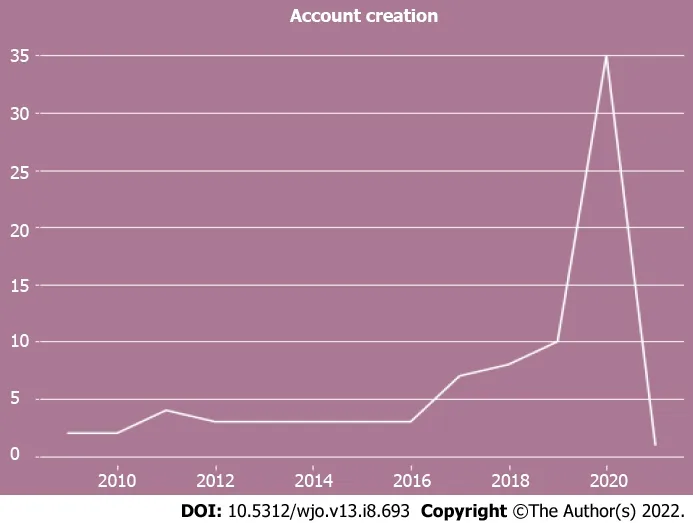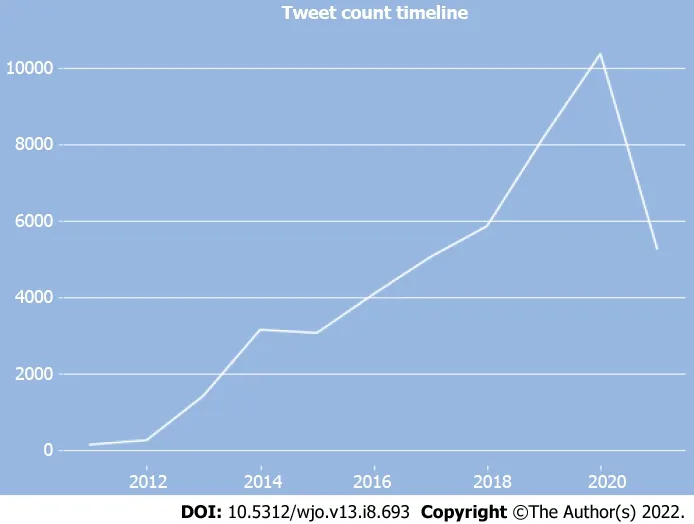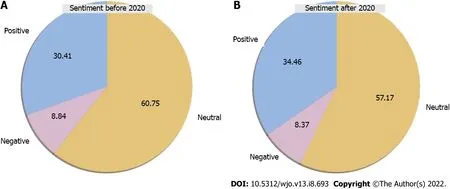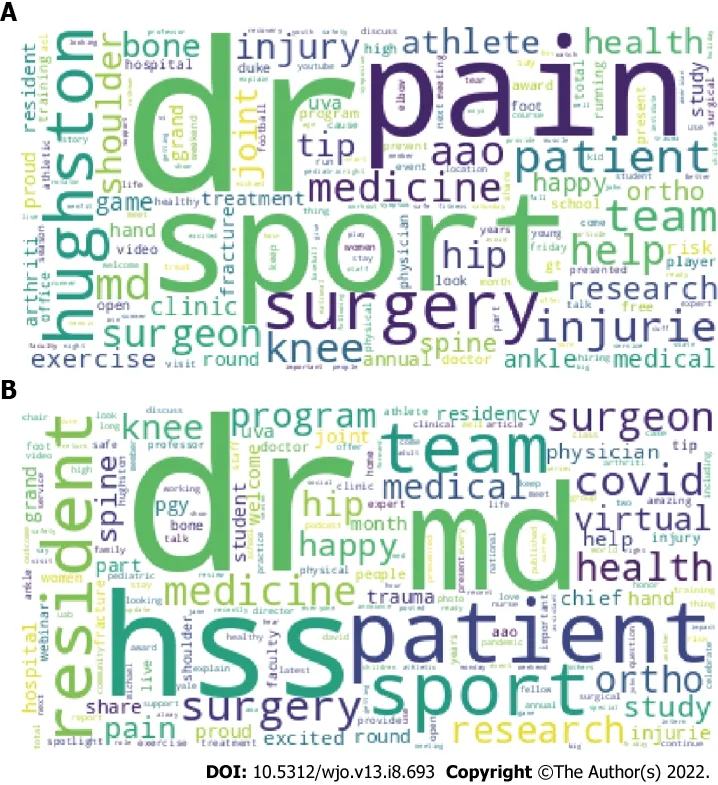Social media growth of orthopaedic surgery residency programs in response to the COVlD-19 pandemic
lNTRODUCTlON
Social media has proven to be a valuable tool for education and collaboration. There are almost 4 billion social media users around the globe, equating to over 50% of the global population[1]. As the use of social media continues to grow in the general population, it has also become an increasingly popular platform for healthcare and global outreach. Other social media platforms, such as Instagram and Twitter, are used for public health outreach, professional networking, and the dissemination of research findings[2]. In the past, orthopaedic surgery social medial presence has been primarily limited to practice management and patient outreach[3].
In the Spring of 2020, residency programs across the country experienced rapid and drastic changes to their application process due to the coronavirus disease 2019 (COVID-19) pandemic. Applicants and programs alike faced novel challenges including the elimination of visiting rotations, in-person interviews, open houses, and social exchanges. For very competitive specialties, such as orthopaedic surgery, applicants lost critical opportunities to display their abilities, earn letters of recommendation, and build relationships at institutions of interest[4]. Similarly, residency training programs did not have the opportunity to showcase their programs and evaluate applicants in person. In response to these changes, residency programs adopted virtual events and began harnessing social media to communicate with applicants. Prior literature reported 85% of interviewees utilized at least one social media platform to learn more about individual programs[5]. Another study showed up to 77.8% of applicants feel that residency programs should be utilizing social media as a means of communication, and the majority of applicants (54.3%) in the 2021 application cycle were influenced by social media with regards to interest in specific residency programs[6]. Considering the new challenges that emerged, social media has allowed programs and applicants with a platform to engage with one another in meaningful ways.
It got to the point where Mrs. Thompson would actually take delight in() making his papers with a broud red pen, making bold Xs and then putting a F at the top of his papers. At the school where Mrs. Thompson taught, she was required to recieve each child s past records and she put Teddy s off until last.
Several studies have looked at social media use in other surgical subspecialties including plastic surgery, urology, general surgery, and otolaryngology[4,7-10]. However, there is limited literature about the changes and trends of social media implementation by orthopaedic surgery residency programs during the COVID-19 pandemic. In the present study, we investigate the use of social media by orthopaedic surgery residency programs in response to the COVID-19 pandemic. We hypothesize that programs have substantially increased their social media presence to address the gaps created by changes in the application and recruitment processes because of the pandemic.
MATERlALS AND METHODS
A list of ACGME-accredited orthopaedic surgery residency programs was compiled from the Fellowship and Residency Electronic Interactive Database (FREIDA) in August 2021. A total of 201 programs were identified. Prior studies have suggested that residency programs more often utilize Instagram and Twitter as platforms for delivery of information as opposed to other similar social media alternatives such as Facebook[11,12]. Therefore, all programs were reviewed for ownership of Instagram and Twitter accounts. Programs were determined to have social media accounts through a Google search and extensive search within each social media platform. On the Google search engine, residency programs were searched using the corresponding program name followed by “orthopaedic surgery residency” and the social media platform of interest. If no evidence of the account of interest, social media specific searches were conducted on Instagram and Twitter using the text “(Program name) orthopaedic surgery residency.” Private or personal social media accounts were excluded. All social media accounts were identified as residency only or department only. A residency account was defined as one that specifically denoted its affiliation with the institution’s residency program. Instagram data was collected and deemed current as of August 11, 2021. Twitter data was collected and deemed current as of July 5, 2021. This study did not require Institutional Review Board approval as all information is publicly available and did not directly involve patient care.
Approximately 47000 tweets from 2011-2021 were extracted through the Twitter application programming interface on July 5, 2021. The following information was extracted: total number of followers, accounts following, tweets, likes, date of account creation, hashtags, and mentions. Natural language processing was utilized for tweet sentiment analysis and classified as positive, neutral, or negative. Statistical analysis was performed using Python 3.8.9 with the libraries NumPy 1.21 and NLTK 3.6.2. Figures were generated using Python, Matplotlib 3.4.2, and Seaborn 0.11.1.
For identified Instagram accounts, the date of first post was used as a proxy for account foundation date. The foundation date was assessed for establishment before or after March 1, 2020 - the date recognized as the start of the COVID-19 outbreak in the United States. Accounts were classified as either a residency or department account and the total number of posts and followers were recorded. Additionally, accounts were noted for having their program website in the biography section as well as specific highlights on their Instagram “story.”
RESULTS
We identified Twitter handles for 85 (42.3%) orthopaedic surgery residency programs, 35 (41.2%) of which joined Twitter in 2020 (Figure 1). From 2011 to 2021, 46807 tweets were extracted. In 2011, there were a total of 127 tweets compared to 8195 in 2019, 10377 in 2020, and 5,270 in 2021 (through July 5, 2021) (Table 1). From 2019 to 2020 alone, there was a 126.6% increase in volume of tweets by orthopaedic surgery residency accounts (Figure 2).



The median number of tweets for all orthopaedic surgery residency programs was 103.5 [interquartile range (IQR) 32.5-563.0], the median number of followers was 474.5 (IQR 205.0-796.5), and the median number of accounts following was 152.5 (IQR 54.5-431.75) (Table 2).
He was ugly, and his hair was matted, and he looked crippledand stunted; they called him the field-laborer s boy, though in thechurch register he was entered as Anne Lisbeth s son

The account with the highest number of tweets was @HSpecialSurgery with 13776 tweets followed by @UVA_Ortho with 5063 and @OrthoAtYale with 899. Before 2020, the most commonly used hashtag (#) by orthopaedic surgery twitter accounts was #hughston, followed by #RothmanOrtho (Figure 3A). After 2020, the most used hashtag by orthopaedic surgery twitter accounts was #COVID-19, followed by #orthotwitter and #OrthoMatch2021 (Figure 3B). Before 2020, the account with the highest number of mentions was @BrianColeMD, followed by @MOR_Docs and @AAOS1 (Figure 4A). After 2020, the account with the highest number of mentions was @HSpecialSurgery, followed by @AAOS1 and @BillLevineMD (Figure 4B).
The sea was quite black and thick, and it was breaking high on the beach; the foam18 was flying about, and the wind was blowing; everything looked bleak19
30.Never saw him: The only stipulation87 for this heroine (and Psyche, her counterpart) to retain all of her new wealth and luxury is that she cannot look upon her spouse. This tale, like Bluebeard, has often been interpreted as a warning against feminine curiosity.Return to place in story.


Sentiment analysis before 2020 revealed 30.4% positive, 60.8% neutral, and 8.8% negative sentiments across tweets (Figure 5A). Interestingly, the positive sentiment percentage increased in 2020 from 30.4% to 34.5% (Figure 5B). Word cloud analysis, a visual representation of word frequency, revealed an emergence of “resident,” “covid,” and “virtual” after 2020 (Figure 6A) compared to before 2020 (Figure 6B).


Of the 201 ACGME-accredited orthopaedic surgery residency programs on FREIDA, 115 (57.2%) participate on Instagram, with 101 (87.8%) identified as residency-rundepartment-run. Over three quarters (77.4%) of accounts were created after March 1, 2020. Additionally, 90 (78.3%) of the identified accounts had a link to the program website in their Instagram (Table 3). To quantify the level of activity and engagementInstagram, we examined the number of followers and posts by programs. The average number of followers per account was 1089.5 (SD = 606.4) with an average of 58.9 (SD = 56.5) total posts (Table 4). The most common post type included advertisements for virtual sessions, resident spotlights, and photos illustrating resident life.
At last, when the fiddler was nearly dead, the little wretch14 left off, and shoved the poor fellow out of the iron gate which he had entered in such good spirits a few hours before


DlSCUSSlON
After March 1, 2020, Instagram account creation amongst orthopaedic surgery residency programs grew 342%. Instagram’s platform, which allows users to post captioned images with no character limit, offers opportunities for posts about resident life and culture. For example, Instagram “stories” offer realtime snapshots documenting the day-to-day life of a resident. Accounts have also posted resident spotlights filled with information about residents’ backgrounds, interests, and personal lives, ultimately providing a glimpse into the personalities and diversity of a programs’ residents[11]. Twitter, on the other hand, is a more text-centered platform and is commonly used in an academic or informative manner[12]. It has provided applicants with the opportunity to directly converse with program directors, residents, and educators in the absence of in-person events. It has also been used as a source of reliable information regarding virtual events and program specific details[13].
The complex nature of COVID-19 has made the residency application process challenging for programs and applicants alike. As a result, orthopaedic surgery residency programs have turned to online platforms such as Instagram and Twitter to showcase their institutions and interact with applicants. Social media has helped fill the void left by limited away rotations, virtual interviews, and an uncertain application process. With the proliferation orthopaedic surgery programs social media use, it is increasingly important to understand the uses and trends associated with each platform.
To our knowledge, there is just one prior study evaluating the effects of the COVID-19 pandemic on social media among orthopaedic surgery residency programs. Yong[3] evaluated Facebook, Twitter, and Instagram use by orthopaedic surgery residency programs in May 2019, July 2020, and November 2020. In their cross-sectional study, the authors found a 300% increase in social media account prevalence amongst orthopaedic surgery residency programs from May 2019 to November 2020, with Instagram experiencing the largest account growth and creation. The authors conclude that the proliferation in social media use by residency programs was directly related to the effects of the COVID-19 pandemic.
Based on the results of Yong[3], we attempted to further evaluate the trends in social media use among orthopaedic surgery residency programs. There are several important differences between the current study and Yong’s results. Our complex algorithm extracted important data from twitter to evaluate a significant number of variables over a ten-year period. Yong examined trends at three points in time over 18-mo. In addition to the variables evaluated by Yong (account creation and number of followers), the present study provides data on total number of tweets per year and median number of tweets per account, allowing for a more in-depth understanding of twitter use amongst orthopaedic surgery programs. Furthermore, we provide specific information on the most active twitter accounts before and after the pandemic, as well as the accounts with the most mentions, which may be important information for applicants looking to network or for programs hoping to increase their twitter presence. Finally, a unique strength of the present study is our use of word cloud analysis, which provides a visual representation of the most tweeted words and phrases by orthopaedic surgery programs, unsurprisingly showing an increased use of the words “covid” and “virtual” after the start of the pandemic.
Recently, I was at it again, going door-to-door looking for one of my own lost kitties, a little black cat named Nicholas who’d slipped out the door before I could stop him. I made my rounds, visiting with all the neighbors, describing Nicholas. Familiar with this routine, everyone promised to keep an eye out and call me if they spotted1 him.
The aim of the study analyze and discuss the various changes in social media usage by orthopaedic surgery residency programs before and during the COVID-19 pandemic.
2. Not quite right about the ladies: As one of the shortest fairy tales, one is always left to wonder what isn t quite right about the other women. Details are not given in the traditional tales although modern interpretations8 have given various reasons, from lack of physical beauty to lack of sensitivity.
As a result of the coronavirus disease 2019 (COVID-19) pandemic, orthopaedic surgery residency programs across the country experienced rapid and drastic changes to their application process. In response, residency programs shifted to virtual events and began harnessing social media to communicate with applicants.
How in the world did you know that? asked Plumb. I packed your parachute, the man replied. Plumb gasped4 in surprise and gratitude5. The man pumped his hand and said, I guess it worked! Plumb assured him, It sure did. If your chutehadn t worked, I wouldn t be here today.
The proliferation of social media use amongst orthopaedic surgery residency programs may pose unforeseen risks to applicants. While following the social media account of a prospective residency program may signal an applicant’s interest, it can also draw attention to the applicant. A 2015 study found that 18% of general surgery residency program directors reported visiting applicants’ social media accounts and 11% admitted to lowering an applicants’ rank as a result of their online activities[18]. The authors of the present study believe programs will increasingly visit the social media accounts of applicants, especially as applicants provide their usernames when they choose to follow the program’s social media account. Applicants must be cognizant of their online etiquette and must consider how their posts may be viewed by future colleagues, employers, and patients[19].
The rise of social media usage amongst orthopedic surgery residency programs has been clearly identified as a factor in the application process for medical students. Social media usage within orthopedic surgery has also been reported in the context of patient education and clinical implications. Specifically, studies have shown that social media is a growing platform for surgeons to communicate with and educate patients in order to improve patient outcomes, but long-term efficacy and practicality of social media in patient communication is still unclear[20]. Within the scope of orthopedic surgery residency programs, the clinical implications of social media are unclear and have not yet been thoroughly studied. It is clear, however, that social media is quickly becoming a critical component of education and training with one study revealing 77% of internal medicine residents utilizing social media for medical education purposes[21]. Several programs have included resident education and training, as well as patient outcomes, as a component of their social media content, but the implications of this with regard to clinical outcomes have not yet been reported in the literature.
After 21 years of marriage, I discovered a new way of keeping alive the spark of love. I started to go out with another woman. It was really my wife s idea.
There are several limitations to our study. Because social media use can only be reported as a snapshot in time, the reported number of posts, followers, and content at the time of data collection may no longer be up to date. Furthermore, while we were thorough in our efforts to identify social media accounts, it is possible that we may not have identified all social media accounts or may have misidentified some. Additionally, we included all social media accounts of orthopaedic surgery programs that have residency programs, whether the account itself was specifically geared towards applicants. While our data shows a decrease in activity from 2020 to 2021, it must be noted that only about half of the year 2021 was included, as data collection was performed on July 5, 2021. It remains to be seen whether twitter and Instagram use will continue to increase as the delta variant surges. Despite these limitations, the authors’ multi-faceted evaluation of social media use amongst orthopaedic surgery residencies is the most comprehensive of its kind in the orthopaedic literature to date.
CONCLUSlON
In response to the challenges of the COVID-19 pandemic, orthopaedic surgery residency programs drastically increased their presence on social media. It is likely that the utilization of social media will continue to persist into the future as platforms such as Instagram and Twitter have illuminated new ways for programs to interact with applicants. With continued uncertainty regarding the pandemic, programs currently not employing social media as a resource should consider it as a legitimate opportunity for outreach and recruitment. Orthopaedic surgery programs should continue to utilize virtual platforms to supplement the traditional interview process; however, virtual interactions should not be seen as a replacement to externships and in-person interviews. Further studies are needed to evaluate the true impact that increased social media use by orthopaedic surgery residency programs has on the application process, as well as the training and education of resident surgeons.
ARTlCLE HlGHLlGHTS
Research background
For most applicants, the transition to a virtual application process has provided increased schedule flexibility, virtual access to information, and a decreased financial burden that comes with interviewing and traveling[7]. Excluding away rotations, the average orthopaedic surgery applicant spends about $7000 on the interview process and submits 85.7 applications[17]. While the virtual application process provides some obvious benefits to applicants, it also creates disadvantages for both programs and applicants. A lack of in-person interviews may prevent programs and applicants from being able to candidly evaluate one another. Furthermore, an inability to experience a program’s culture and city in person may make it difficult for an applicant to picture him or herself moving to that location for five or more years. These challenges are magnified by the fact that most away rotators are limited to one externship, whereas prior to the pandemic, applicants would routinely complete two or more away rotations. This is especially difficult for applicants, as many view their sub-internships as an opportunity to make an impression, obtain letters of recommendation, show interest at specific programs, and evaluate their comfort and lifestyle in a new city. Based on the aforementioned information, orthopaedic surgery programs should continue to utilize virtual platforms to supplement the traditional interview process, as they have been shown to influence interest in certain programs for the majority of orthopedic surgery applicants[6]. However, virtual interactions should not be seen as a replacement to externships and in-person interviews.
Research motivation
Social media has become an integral part of business, education, and networking. However, there is scarce literature that explores the use of social media amongst orthopaedic surgery residency programs, specifically in response to the ongoing COVID-19 pandemic.
Further studies are needed to evaluate the true impact that increased social media use by orthopaedic surgery residency programs has on the application process.
Research objectives
Several studies have shown similar increases in social media usage within other specialties, including neurology, pediatrics, and otolaryngology. Following the start of the pandemic, Gaini[14] reported almost half of the neurology residency programs on social media announced at least one online virtual eventtheir website or social media. This suggests that social media has not only been used to connect with applicants, but also to announce virtual opportunities. Pruett[15] found that pediatric residency programs utilize social media to highlight resident wellness, program culture, and resident lifestyle. The authors also suggest that residency programs should increase the number of virtual opportunities applicants have to engage in live conversation with residents and faculty. Ahmadmehrabi[16] found that 61% of otolaryngology programs have at least 1 social media account, with Twitter being used to facilitate dialogue between applicants, programs, and various institutions. In short, many residency programs across numerous medical specialties have found unique ways to harness social media in the post-pandemic application process.
So he called together all the shipbuilders throughout the country, and gave them orders to build a ship which should float on the land as well as on the sea
Research methods
Orthopaedic surgery programs were reviewed for social media presence on Instagram and Twitter. Instagram accounts were tallied for followers, number of posts, and date of creation. Twitter posts were characterizedtype of post and sentiment using natural language processing.
Research results
In response to the pandemic, orthopaedic surgery residency programs greatly increased their presences on Instagram and Twitter. Both platforms were used in a similar manner to engage with applicants, however, it remains unknown what the impact this had on prospective applicants.
Research conclusions
Our study demonstrates a substantial growth of Instagram and Twitter presence by orthopaedic surgery residency programs associated with the COVID pandemic. This data suggest that orthopaedic surgery residency programs have utilized social media as a new way to communicate with applicants and showcase their programs in light of the challenges presented by the pandemic. The authors anticipate the current trend in social media will plateau as the visiting student precautions are returned to normal before stabilizing as a present but less pervasive means of communication.
Research perspectives
Prince Asmund dearly loved all outdoor sports and an open-air life, and from his earliest childhood he had longed to live entirely4 in the forest close by
FOOTNOTES
Geller JS, Massel DH, Rizzo MG, Schwartz EC, Milner JE, and Donnally CJ contributed to the design and implementation of the research, to the analysis of the results, and to the writing of the manuscript; all authors have read and approve the final manuscript.
As the data utilized to conduct this study is publicly available, this study was exempt from the need for institutional review board approval.
As the data utilized to conduct this study is publicly available, this study was exempt from the need for informed consent.
All authors report no relevant conflict of interest for this article.
No additional data are available.
This article is an open-access article that was selected by an in-house editor and fully peer-reviewed by external reviewers. It is distributed in accordance with the Creative Commons Attribution NonCommercial (CC BYNC 4.0) license, which permits others to distribute, remix, adapt, build upon this work non-commercially, and license their derivative works on different terms, provided the original work is properly cited and the use is noncommercial. See: https://creativecommons.org/Licenses/by-nc/4.0/
United States
Joseph S Geller 0000-0003-4213-8975; Dustin H Massel 0000-0002-8147-5555; Michael G Rizzo 0000-0003-3307-9328; Ean Schwartz 0000-0002-5534-6653; Jacob Eric Milner 0000-0002-2136-8416; Chester J Donnally III 0000-0002-1701-0745.
Wu YXJ
A
Wu YXJ
 World Journal of Orthopedics2022年8期
World Journal of Orthopedics2022年8期
- World Journal of Orthopedics的其它文章
- Rates of readmission and reoperation after operative management of midshaft clavicle fractures in adolescents
- Bilateral hip heterotopic ossification with sciatic nerve compression on a paediatric patient-An individualized surgical approach: A case report
- Quantitative alpha-defensin testing: ls synovial fluid dilution important?
- Effect of pelvic fixation on ambulation in children with neuromuscular scoliosis
- Epidemiology of pelvic and acetabular fractures across 12-mo at a level-1 trauma centre
- Risk modeling of femoral neck fracture based on geometric parameters of the proximal epiphysis
